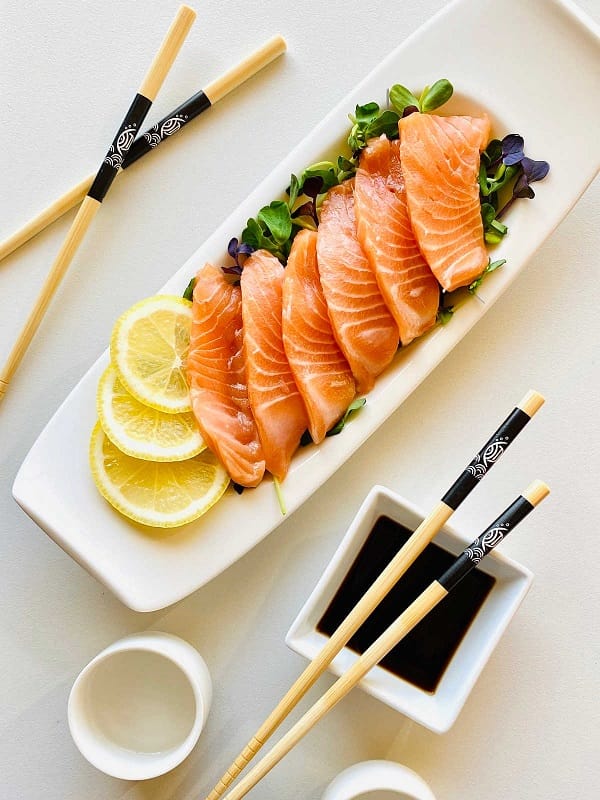In sashimi, the exquisite art of thinly sliced raw fish salmon reigns supreme as one of the most beloved and sought-after selections. However, not all of them are equal regarding the perfect sashimi experience.
As you embark on your sashimi journey, it’s crucial to understand the nuances of the various varieties and how they factor into crafting the ultimate sashimi delight.
Not All Salmon Are Created Equal: Understanding Varieties
Regarding sashimi, not every commercially available salmon is suitable for consumption in its raw form. There are safety concerns to consider, as some salmon may harbor parasites or other potential health risks.
To ensure a safe and enjoyable sashimi experience, it’s essential to look for salmon specifically designated as “sushi-grade” or “sashimi-grade,” indicating that it has been handled and frozen in a way that eliminates any potential parasites.
Fatty Favorites: Salmon Ideal for Sashimi

Among the salmon varieties considered ideal for sashimi, the ones with a higher fat content tend to shine. These fatty salmon varieties offer a rich, buttery flavor and divine melt-in-your-mouth texture.
- One standout option is King Salmon (Chinook), often considered the crème de la crème of sashimi-grade salmon in the American market. Its buttery texture and robust flavor make it a true sashimi connoisseur’s delight.
- Another excellent choice is the Coho (Silver Salmon), which offers a delightful balance of fat and flavor with a slightly lighter texture than its King Salmon counterpart.
- For those seeking a slightly firmer texture with a balanced flavor profile, the vibrant Sockeye (Red Salmon) is a fantastic option, boasting a stunning red hue that is as visually appealing as it is delicious.
Freshness First: Sourcing the Best Salmon
Regardless of the salmon variety, freshness is paramount regarding sashimi. When purchasing salmon for sashimi at home, look for fish with bright, clear eyes, vibrant flesh color, and a firm, supple texture.
Reputable fishmongers or sushi restaurants prioritizing sourcing high-quality sushi-grade are your best bet for ensuring a safe and exceptional sashimi experience.
Beyond the Big Three: Exploring Other Options
While the King, Coho, and Sockeye are the go-to favorites for sashimi, some adventurous sushi chefs might experiment with other varieties, such as Atlantic Salmon (farmed) or Keta Salmon (Chum). These options might have a lower fat content and slightly different flavor profiles, but ensuring they are also sushi-grade for safe consumption is essential.
Trusting the Experts: Ordering Sashimi with Confidence
When dining at a sushi restaurant, you can trust that the establishment uses sushi-grade or sashimi-grade salmon in their dishes. Reputable sushi chefs take great pride in sourcing the finest quality seafood to deliver an exceptional sashimi experience.
FAQs
Are there any rare salmon toppings recommended for the dish?
Yes, toppings such as Masunosuke Tokishirazu Keiji or Sakuramasu can provide a unique and delightful experience with their Edo-style sushi that enhances the salmon’s umami flavor without overpowering its natural taste.
Which website provides basic knowledge on different types of salmon?
Sushi University offers valuable information on the various types of salmon used in sushi, helping both chefs and guests navigate the world of seafood with confidence and insight.

Welcome to the world of Chef Gary! Meet Chef Gary, a culinary maestro whose journey from Indonesia to the United States has been nothing short of extraordinary. Immigrating in the early 2000s, Chef Gary began his culinary career as a Sushi Chef at renowned establishments such as Japonais Restaurant in Chicago, followed by stints at Benihana and Ginza in Indiana.
With a passion for perfection and a dedication to his craft, Chef Gary’s career blossomed as he made his mark in the Sunshine State, serving as the Head Sushi Chef at Modern Asian restaurants in Palm Beach. However, his two-year sojourn in New Delhi, India, shaped his culinary prowess, propelling him to the prestigious role of Executive Chef at Nehru Place – Benihana.

